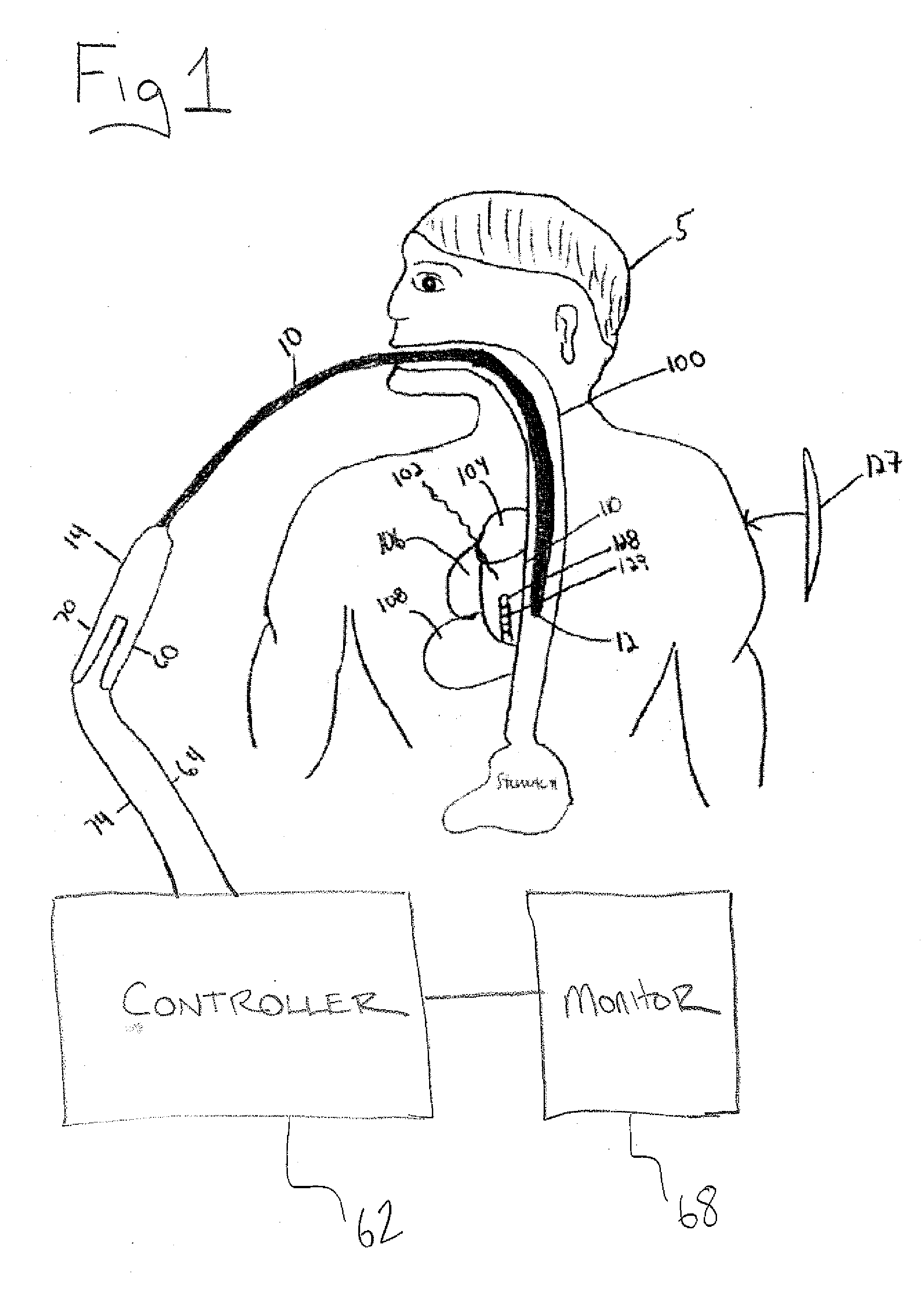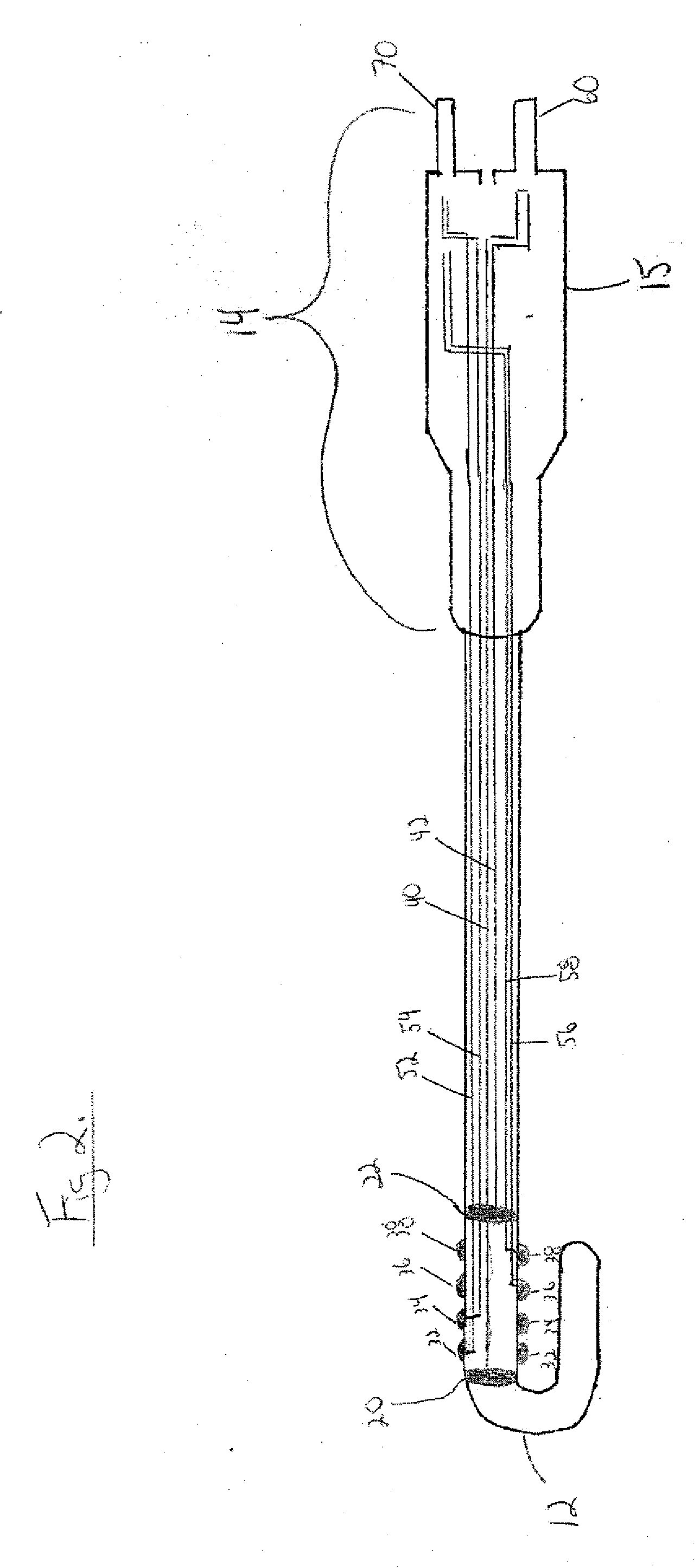An atrial esophageal
fistula is a rare, but almost always a lethal complication.
A problem with such known procedures is that there is presently a
high rate of esophageal injuries.
The ongoing
high rate of esophageal
thermal injury, despite luminal esophageal temperature (LET) monitoring, is specifically related to the limitations of current techniques and medical devices used for LET monitoring.
For example, there is often suboptimal orientation and positioning of the LET probe in relationship to the site of radiofrequency application in the heart, which results in an underestimation of the true LET and leads to esophageal injury due to unseen temperature rises.
Current modalities reduce but do not eliminate
left atrial-esophageal fistulas.
Esophageal injury is associated with a
high mortality rate in addition to numerous co-morbidities.
Fistula formation is thought to occur due to conductive
heat transfer to the esophagus that causes trans-mural tissue injury leading to a fistulous connection between the esophageal lumen and the
left atrium, leading to
sepsis,
stroke and eventual death.
Unfortunately, there is no clear method to accurately define the precise location of the esophagus.
A
disadvantage of these known systems and methods is that they do not provide live
visualization of the probe itself within the anatomic shell of the esophagus.
Another
disadvantage of known systems and methods is that it has not been possible to non-fluoroscopically visualize the location of a temperature sensor within the esophagus relative to the distal end of an intra-
cardiac ablation catheter prior to each
ablation, limiting the accuracy of the temperature readings.
This problem is compounded because of variability in left atrial and esophageal
anatomy, including the
esophageal wall thickness.
A
disadvantage of this device is that it does not enable the creation of a live, continuously updating electroanatomic or thermal shell of the esophagus.
Another disadvantage of the device disclosed in U.S. Pat. No. 7,819,817 is that it requires a permanent
balloon for positioning the probe.
The
balloon serves to anchor the esophagus in one location and limits natural esophageal mobility; thus, increasing the potential for esophageal injury to that anchored location.
In addition, the balloon can cause great discomfort to the patient both on
swallowing and with prolonged inflation during the procedure.
The permanent cable and balloon add increased size and stiffness and increases the risk for trauma to the esophageal lumen.
Unfortunately, studies have shown that despite these
imaging modalities being performed within 24 hours of the procedure, there was still significant migration of the esophagus up to 15 mm in less than 24 hours.
Thus, imaging the esophagus prior to the procedure is inadequate to locate the true and precise
anatomic location of the esophagus.
Clinical studies have shown that leaving an esophageal echocardiography probe in the esophagus throughout the procedure leads to a higher risk of esophageal-atrial fistulas.
A disadvantage of this device is that it is solely a temperature-sensing device and does not include any electrodes.
In addition, the operator can not visualize this device within the esophagus in real time during the procedure due to the lack of electrodes; thus, precluding
live feedback to the operator in regards to the relative distance between the esophageal device and the
cardiac ablation catheter.
However, clinical studies have shown that cooling systems are not effective in cooling the deep muscular
layers of the esophagus, which are the initial sites of
thermal injury in contact with the
left atrium and serve as the origin for
fistula formation.
Thus, the
catheter simply cools the exposed surface area of the esophagus, which is not only ineffective in protecting the esophagus but also causes great discomfort to the patient.
A disadvantage of the type of
system is that there is no direct
visualization of the esophagus or atrium via an anatomic or thermal map.
Furthermore, proximity is indicated by measured proximity signals, which can be inaccurate secondary to the anatomic variability between the two catheters.
A disadvantage of this catheter is that it only provides a static esophageal map.
It does not provide live and continuous temperature readings, nor does it allow for concomitant
cardiac pacing or sensing or have the capability to create a live three dimensional and continuously updating esophageal thermal map.
 Login to View More
Login to View More  Login to View More
Login to View More 


